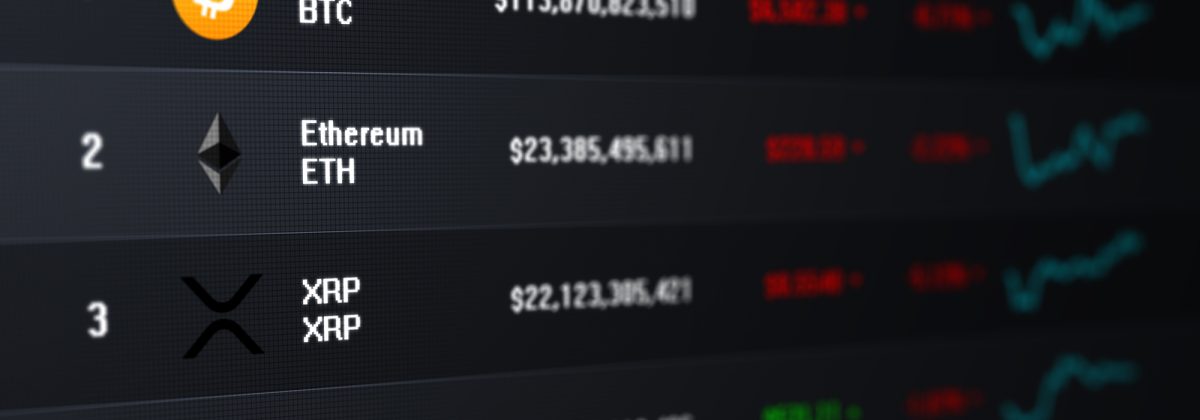In late June 2019, the 4 top cryptocurrencies, in terms of market capitalisation, made huge gains, adding some $30 billion to the total cryptocurrency market cap over a span of just two days. Bitcoin, Ether, Litecoin and Ripple, all registered double-digit gains, with the price of Bitcoin crossing the $10,000 mark for the first time since January 2018.
Experts believe that the recent price rally in major cryptocurrencies can be attributed to increased interest in the digital assets space by institutional investors and Silicon Valley tech giants. We know that Facebook has recently announced its plans to launch its own cryptocurrency, Libra, which has functionalities similar to Bitcoin.While Bitcoin’s dominance is rapidly growing in the cryptocurrency market, altcoins like Ether, Litecoin and Ripple are giving it tough competition. This begs the question, which of these coins have the greatest potential in future?
Bitcoin (BTC)
After a harsh crypto winter through 2018, BTC made significant gains in 2019. It started the year a little below $4,000, beginning its rally with around a 20% gain by April 2019. By June 26, 2019, BTC was trading at $13,387, making a gain of almost 260% since January. As of July 27, 2019, the digital currency was trading at $10,096, with a market cap of $181 billion. Investment analysts and Bitcoin experts believe that Bitcoin might well repeat its historic performance of 2017 and reach the $20,000 mark by the end of 2019.
BTC still remains the most trusted and established cryptocurrency. It thrives well on criticism and media reports. Price corrections in mid-July 2019 coincided with Facebook’s Libra hearings on Capitol Hill and President Trump’s staunch remarks (“not a fan of Bitcoin”). Even China’s ban on Bitcoin and its heavy intervention policies have not been able to stem crypto’s growth. It has seen increased acceptance in countries dealing with economic instability and political crises.
On July 23, 2019, Venezuela registered the highest ever trading volumes, to escape a 10,000,000% inflation rate on the Venezuelan Bolivar. But, high volatility still remains a concern for trade analysts. The US SEC has already rejected proposals regarding Bitcoin ETFs, several times in a row, expressing concerns regarding high volatility and price manipulation.
Yet, Bitcoin has sound future potential for several reasons including its high adoption rate, the increasingly dovish stance taken by Central Banks worldwide, and the possible approval of Bitcoin futures, which might take its price to $100,000 by 2022.
Ether (ETH)
Ethereum started the year trading at a price of $135, rising to $343 by June 2019. However, ETH has been unable to cross its highest price of $1,432, reached in January 2018. Experts predict a bullish medium-term outlook for Ether, with a slow and steady rise in price momentum. If it continues on its current price trajectory, the coin could well reach a price of $500 by the end of 2019.
The sluggish price movement can be attributed to the failure of a large number of Ethereum-based ICO projects in 2018. But the coin strongly reacts to a surge in Bitcoin prices, and if BTC continues to surge, ETH could register 1,000% gains on BTC ratio. On July 26, 2019, the US SEC approved the first ever ERC-20 standard token sale, for a blockchain-based gaming platform, Pocketful of Quarters (PoQ). With increasing regulatory approvals for Ethereum-based blockchain projects, like that of the gaming start-up PoQ, the value of the coin is expected to also increase. Investors have become overly cautious regarding super-hyped ICO projects that don’t take off, which means only credible platforms will emerge and survive.
Large number of ICOs and their associated transaction volumes had crowded the network and increased transaction times. But the Ethereum community is working towards Layer Two technology, which will increase scalability and prove transformative for the network. It might pave the way for radical new solutions, including value transfer, governance, incentive structures and even implementation of tax policies, built on Ethereum.
Ripple (XRP)
Ripple’s power lies in its high adoption rates by established and trusted banking institutions, which are household names globally. Unlike some of its peers, XRP has the strongest real-world adoption use cases. Transaction speeds are higher and fees are much lower than that of Bitcoin, Ether and Litecoin. The cross-border payment system, RippleNet, has been sometimes called a better alternative to fiat payment systems like SWIFT and Western Union.
Ripple has formed numerous strategic partnerships with top investment banks and other financial institutions. It is a lucrative venture, which will continue to attract investors from across the world, thereby increasing its international credibility. It remains one of the cheap coins to invest in, with highly scalable network infrastructure.
Its limitations, however, lie in its blockchain structure, where Ripple alone owns 50% of the total XRP supply. Experts believe that this could prove to be a hindrance in predicting the coin’s price in the future. Its consensus ledger approach differs from the usual cryptocurrency networks, where “non-validated” participants cannot provide validation. Also, the Ripple management team does not have any further plans for the coin. They are focused on RippleNet, with XRP being a secondary priority. This limits its potential for growth.
Litecoin (LTC)
Litecoin has been a surprising performer, registering growth of 360%, from January to July 2019. It those terms, it has managed to outpace other coins, like Ether and Ripple, and even Bitcoin. Its meteoric rise has been attributed to the network’s upcoming “halvening,” where the number of coins that can be mined by a miner will be reduced by 50%. This is not only to create demand, but also to prevent erosion of value.
The halvening process usually takes place every 4-years, and the last time that it occurred in 2015, LTC gained 60% in the preceding three months. But Litecoin mimics Bitcoin’s value, which means that if the latter falls, the former will cease to have value. Litecoin transactions have also fallen drastically by 84% since its highest price in January 2018. The transaction fees on the network have seen high volatility, which hinders app developments on this network.
In the short-term, trading opportunities seem to be aplenty for Litecoin traders, especially in the days leading up to the halvening. But its long-term prospects depend on its increased use by merchants.
Reference Links





